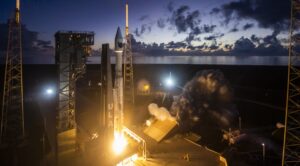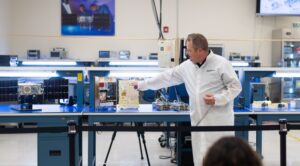DARPA selects companies for inter-satellite laser communications project
Wednesday, 10 August 2022 18:51
Eleven organizations were selected by DARPA to help develop laser terminals and technical standards to connect satellites in space.
The post DARPA selects companies for inter-satellite laser communications project appeared first on SpaceNews.
NASA cubesat bumped from rideshare launch because of orbital debris mitigation concerns
Wednesday, 10 August 2022 17:25
A NASA cubesat was removed from a recent rideshare launch opportunity on a U.S. Space Force mission because the spacecraft could not meet guidelines for deorbiting at the end of its life.
First cubesat completed for NASA space science constellation
Wednesday, 10 August 2022 15:00
The Space Dynamics Laboratory has completed the first of a constellation of cubesats for NASA that will act as a giant radio telescope in space to study space weather.
The post First cubesat completed for NASA space science constellation appeared first on SpaceNews.
Student payloads to fly on RocketStar suborbital test flight
Wednesday, 10 August 2022 13:49
TriSept Corp. has integrated two experimental payloads built by university students on a RocketStar suborbital test flight scheduled to launch next month.
The post Student payloads to fly on RocketStar suborbital test flight appeared first on SpaceNews.
NanoAvionics expands into heavier smallsat market
Wednesday, 10 August 2022 13:25
NanoAvionics said Aug. 10 it has extended its range of modular satellite buses in another step toward the heavier end of the small satellite market.
The post NanoAvionics expands into heavier smallsat market appeared first on SpaceNews.
Capella unveils a new generation of radar satellites
Wednesday, 10 August 2022 12:00
Capella Space intends to offer improved image resolution and quality with a new generation of synthetic aperture radar satellites, called Acadia, scheduled to launch in early 2023.
The post Capella unveils a new generation of radar satellites appeared first on SpaceNews.
NASA Announces New CubeSat Launch Initiative Partnership Opportunities
Wednesday, 10 August 2022 10:36 NASA has announced a new round of opportunities through the agency's CubeSat Launch Initiative (CSLI) for CubeSat developers, including educational institutions, to conduct scientific investigations and technology demonstrations in space and contribute to the agency's exploration goals.
"Small satellites, such as CubeSats play a valuable role in the agency's educational, science, and techn
NASA has announced a new round of opportunities through the agency's CubeSat Launch Initiative (CSLI) for CubeSat developers, including educational institutions, to conduct scientific investigations and technology demonstrations in space and contribute to the agency's exploration goals.
"Small satellites, such as CubeSats play a valuable role in the agency's educational, science, and techn Benchmark to keep popular orbits safer with collision avoidance kit
Wednesday, 10 August 2022 10:36 With the most popular, revenue-generating orbits increasingly congested, Benchmark Space Systems has unveiled a breakthrough Collision Avoidance (ColA) Kit, featuring its heritage propulsion technology in a condensed package, that is easily and affordably deployed aboard electric propulsion (EP) and non-propulsive microsatellites and OTVs to help them quickly steer clear of approaching spacecraf
With the most popular, revenue-generating orbits increasingly congested, Benchmark Space Systems has unveiled a breakthrough Collision Avoidance (ColA) Kit, featuring its heritage propulsion technology in a condensed package, that is easily and affordably deployed aboard electric propulsion (EP) and non-propulsive microsatellites and OTVs to help them quickly steer clear of approaching spacecraf AST SpaceMobile's BlueWalker 3 test satellite arrives at Cape Canaveral
Wednesday, 10 August 2022 10:36 AST SpaceMobile, Inc. ("AST SpaceMobile") (NASDAQ: ASTS), the company building the first and only space-based cellular broadband network accessible directly by standard mobile phones, has announced that its BlueWalker 3 test satellite (BW3) has arrived at Cape Canaveral. The satellite recently departed an off-site testing facility in California after collecting flight data for the upcoming plann
AST SpaceMobile, Inc. ("AST SpaceMobile") (NASDAQ: ASTS), the company building the first and only space-based cellular broadband network accessible directly by standard mobile phones, has announced that its BlueWalker 3 test satellite (BW3) has arrived at Cape Canaveral. The satellite recently departed an off-site testing facility in California after collecting flight data for the upcoming plann CST signs agreement with Gilmour Space for the launch of 50kg to LEO
Wednesday, 10 August 2022 10:36 Commercial Space Technologies Ltd (CST) has signed an agreement with Australian launch provider, Gilmour Space Technologies, to offer a launch capacity of up to 50 kilograms on their Eris Block 1 vehicle.
The combination of Gilmour Space's orbital launch services and full CST oversight will offer an affordable launch solution to satellite customers needing access to custom low earth orbits
Commercial Space Technologies Ltd (CST) has signed an agreement with Australian launch provider, Gilmour Space Technologies, to offer a launch capacity of up to 50 kilograms on their Eris Block 1 vehicle.
The combination of Gilmour Space's orbital launch services and full CST oversight will offer an affordable launch solution to satellite customers needing access to custom low earth orbits Spaceflight and SAB partner to fly Sherpa OTVs on Vega missions
Wednesday, 10 August 2022 10:36 Spaceflight Inc., the leading global launch services provider, has announced it signed an agreement with SAB Launch Services S.r.l. (SAB LS) to fly its Sherpa orbital transfer vehicles (OTVs) on Arianespace Vega missions. The agreement extends Spaceflight launch capacity on European missions managed by Arianespace for Spaceflight's OTV-based services on launches starting as soon as next year. Th
Spaceflight Inc., the leading global launch services provider, has announced it signed an agreement with SAB Launch Services S.r.l. (SAB LS) to fly its Sherpa orbital transfer vehicles (OTVs) on Arianespace Vega missions. The agreement extends Spaceflight launch capacity on European missions managed by Arianespace for Spaceflight's OTV-based services on launches starting as soon as next year. Th NASA data on plant 'sweating' could help predict wildfire severity
Wednesday, 10 August 2022 10:36 A new study uses data from the ECOSTRESS instrument aboard the space station to better understand why some parts of a wildfire burn more intensely than others. Even in drought-stricken California, not all areas face the same degree of wildfire risk.
A recent study featuring data from NASA's ECOSTRESS mission found relationships between the intensity of a wildfire and the water stress in pl
A new study uses data from the ECOSTRESS instrument aboard the space station to better understand why some parts of a wildfire burn more intensely than others. Even in drought-stricken California, not all areas face the same degree of wildfire risk.
A recent study featuring data from NASA's ECOSTRESS mission found relationships between the intensity of a wildfire and the water stress in pl China launches terrestrial ecosystem carbon monitoring satellite
Wednesday, 10 August 2022 10:36 China successfully launched a terrestrial ecosystem carbon monitoring satellite and two other satellites from the Taiyuan Satellite Launch Center in north China's Shanxi Province Thursday.
The satellites were launched at 11:08 a.m. (Beijing Time) by a Long March-4B carrier rocket and entered the planned orbit successfully.
The carbon monitoring satellite is mainly used for terrestria
China successfully launched a terrestrial ecosystem carbon monitoring satellite and two other satellites from the Taiyuan Satellite Launch Center in north China's Shanxi Province Thursday.
The satellites were launched at 11:08 a.m. (Beijing Time) by a Long March-4B carrier rocket and entered the planned orbit successfully.
The carbon monitoring satellite is mainly used for terrestria Lockheed Martin's next gen interceptor achieves communications testing milestone
Wednesday, 10 August 2022 10:36 Lockheed Martin recently validated prototype communications radio technology for the Next Generation Interceptor (NGI) during a recent test milestone.
The NGI's mission is to protect the U.S. homeland from increasing and evolving intercontinental ballistic missile threats. Critically, the interceptor and its components must be able to receive and share data from the ground and throughout t
Lockheed Martin recently validated prototype communications radio technology for the Next Generation Interceptor (NGI) during a recent test milestone.
The NGI's mission is to protect the U.S. homeland from increasing and evolving intercontinental ballistic missile threats. Critically, the interceptor and its components must be able to receive and share data from the ground and throughout t Space Accelerator catalyses multi-million pound investment
Wednesday, 10 August 2022 10:36 Space start-ups generated almost 9 million pounds in investment and created 80 new jobs after taking part in a UK Space Agency-backed business support programme.
The UK Space Agency Space Accelerator Programme, delivered by Entrepreneurial Spark, worked with entrepreneurs from all over the UK aged between 18-70, with business expertise in sectors such as aerospace, law, quantum technology,
Space start-ups generated almost 9 million pounds in investment and created 80 new jobs after taking part in a UK Space Agency-backed business support programme.
The UK Space Agency Space Accelerator Programme, delivered by Entrepreneurial Spark, worked with entrepreneurs from all over the UK aged between 18-70, with business expertise in sectors such as aerospace, law, quantum technology, 